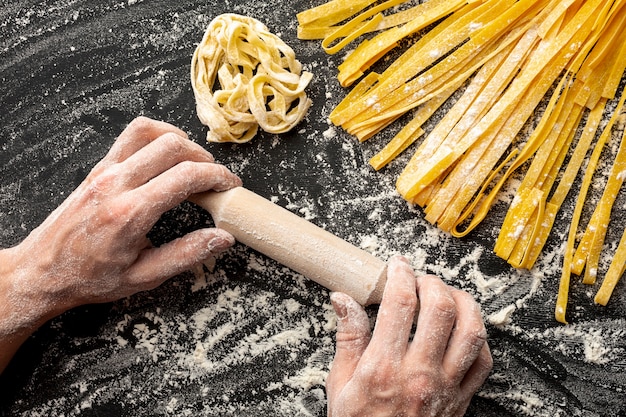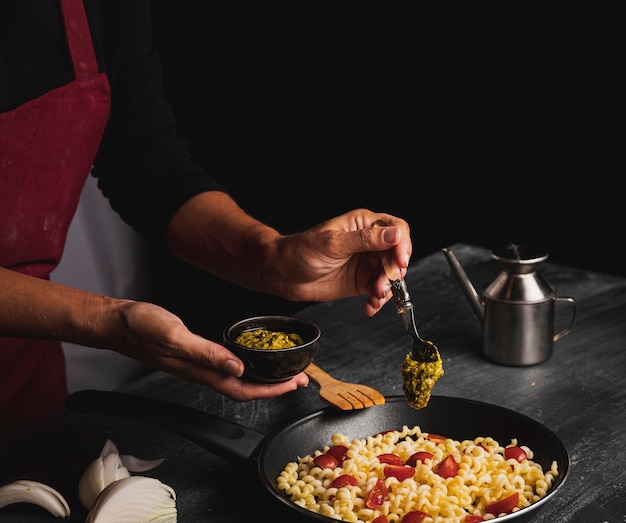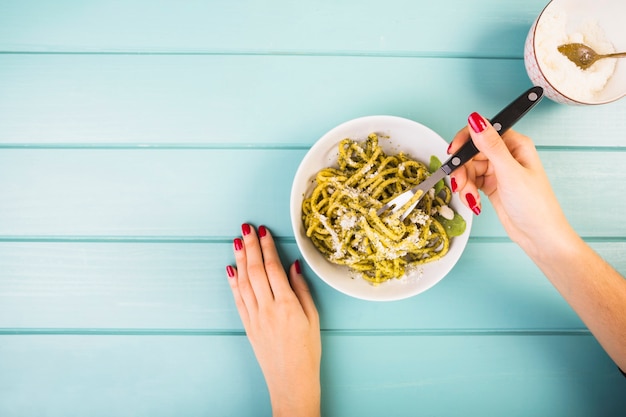Let's face it, pasta is a staple in most kitchens. It's versatile, affordable, and undeniably delicious. But there's nothing worse than biting into a plate of overcooked, mushy pasta. It's a culinary crime! That's why we're going to dive into the world of pasta cooking, uncovering the secrets to achieving that perfect al dente texture.
From choosing the right pasta to understanding cooking times and mastering the art of draining, this guide will equip you with the knowledge you need to make pasta like a pro. We'll even touch upon some common mistakes to avoid, because we've all been there – those unfortunate pasta mishaps that leave us questioning our cooking skills.
(Part 1) Choosing the Right Pasta

The journey to perfect pasta begins with choosing the right type. It's not just about picking your favorite shape, but understanding how different pasta shapes complement various sauces and create unique culinary experiences.
The Shape of Things
The world of pasta shapes is a fascinating one, and each shape holds a unique purpose. Think of it like having a different tool for different jobs in your kitchen. Here's a quick guide to common pasta shapes and their ideal pairings:
- Long and thin: Spaghetti, linguine, angel hair – these are the classics. They're fantastic for long, thin sauces like aglio e olio, puttanesca, or a simple tomato sauce. Their long, slender strands are also perfect for twirling on your fork, creating that quintessential Italian dining experience.
- Short and stubby: Penne, rigatoni, and fusilli are like little bowls designed to trap chunky sauces like bolognese, ragu, or pesto. They're also fantastic in dishes like pasta bakes, where their sturdiness holds up well to baking.
- Flat and wide: Fettuccine, pappardelle, and tagliatelle are perfect for creamy sauces or sauces with mushrooms, meat, or vegetables. Their wide surface area allows for generous sauce coverage, ensuring every bite is bursting with flavor.
- Shaped for filling: Tortellini, ravioli, and agnolotti are designed to be filled with delicious cheeses, meats, or vegetables. They’re usually served in light broths or sauces, allowing the delicate flavors of the fillings to shine through.
- Other shapes: Orzo, farfalle (bow tie pasta), and conchiglie (shell pasta) are the fun and versatile shapes of the pasta world. They can be used in a variety of dishes, from soups and salads to pasta bakes and more.
What’s in a Brand?
While I'm not a pasta purist, I do believe that using high-quality, dried pasta made with durum wheat semolina makes a difference. This type of pasta holds its shape beautifully and has a lovely "bite" or "chew" to it. However, there are countless brands and options available, so choose the ones that suit your taste and budget.
(Part 2) cooking pasta: The Essentials

Now that we've chosen our pasta, let's get to the heart of the matter – the cooking process. Don't underestimate the simplicity of cooking pasta. There are a few key steps that can elevate your pasta from a mere side dish to a culinary masterpiece.
The Right Pot
First things first, get yourself a large pot. It's essential to have enough room for your pasta to cook evenly without sticking together. A general rule of thumb is to use a pot large enough to hold three times the amount of pasta you're cooking. Imagine cooking for two people? Then, use a pot that could hold enough pasta for three. This ensures sufficient space for the pasta to move freely and cook evenly.
The Magic Number: Water
The next essential ingredient is water, and not just any water. You need plenty of it! The ideal ratio is about 6-8 cups of water for every pound of pasta. The water should cover the pasta completely. This generous amount of water plays a crucial role in preventing the pasta from sticking together. Why? Pasta releases starch during cooking, and having enough water helps dilute that starch, creating a smoother cooking experience. Additionally, this large volume of water helps maintain a consistent simmering temperature, ensuring even cooking.
Salt, Salt, Salt!
Don't be shy when it comes to salting your water. A well-salted pot of water makes a world of difference in the flavor of your pasta. Think of it like seasoning your food as it cooks, infusing the pasta with a delicate, salty depth. I usually add a tablespoon or two of salt to a pot of water, but adjust the amount to your taste.
(Part 3) The Art of Timing: How Long to Cook Pasta

The question that plagues every pasta cook: how long do you cook pasta for? The answer isn't as straightforward as you might think. Each pasta shape and brand has its own ideal cooking time.
Read the Package!
The pasta package is your best friend! It's where you'll find the recommended cooking time for your chosen pasta. But remember, this is just an average. It's crucial to check for doneness yourself.
Don't Overcook It!
This is where things get tricky. You want your pasta to be cooked through but still have a slight bite, that's what we call al dente. Overcooked pasta becomes mushy, losing its texture and delightful chewiness.
Test It Out
The best way to determine if your pasta is cooked perfectly is the tried-and-true "bite test." Using tongs, grab a piece of pasta and bite into it. It should be firm but not hard. If it's soft and gives easily, it's overcooked. If it's too hard, it needs a bit more time.
Variations in Cooking Time
While the package provides a general guideline, cooking times can vary depending on several factors:
- The thickness of the pasta – thicker pasta takes longer to cook than thinner pasta.
- The amount of pasta – more pasta will take longer to cook than less pasta.
- The altitude – at higher altitudes, you might need to adjust the cooking time slightly. The lower atmospheric pressure can affect boiling points, potentially altering cooking times.
(Part 4) Pasta Cooking: A Step-by-Step Guide
With the essentials covered, let's walk through the actual pasta-cooking process. Follow these steps, and you'll be a pasta pro in no time!
Step 1: Bring the Water to a Boil
Fill your large pot with water, add salt, and bring it to a roaring boil over high heat. Make sure the water is bubbling vigorously – this ensures that the pasta cooks quickly and evenly.
Step 2: Add the Pasta
Once the water is boiling furiously, carefully add your pasta to the pot. Stir gently to prevent sticking. I usually give it a good stir for the first minute to ensure that all of the pasta is submerged and gets coated evenly in the hot water.
Step 3: Cook, Stir, and Taste
Cook the pasta according to the package directions, stirring occasionally to prevent sticking. Don't just set a timer and walk away. Keep a close eye on your pasta, especially towards the end of the recommended cooking time. Remember, the bite test is your best friend!
Step 4: Drain the Pasta
Once the pasta is cooked perfectly, it's time to drain it. But don't just toss it all into the colander. There's a little trick that can elevate your pasta game!
(Part 5) The Drain and Save Method
I learned this trick from my grandma, and it's been a game-changer for my pasta. Reserve some of that starchy pasta water! It's a magical ingredient that can transform your sauce into something truly special.
How to Save Pasta Water
Before draining the pasta, use a ladle to scoop out about half a cup of the starchy cooking water. This water is full of flavor and starch, which can be used to adjust the consistency of your sauce.
How to Use the Pasta Water
When you combine the cooked pasta with your sauce, add a little bit of that saved pasta water. It will help the sauce cling to the pasta more evenly, creating a luxuriously creamy texture. It's also great for adding a subtle depth of flavor to your sauce.
(Part 6) Mistakes to Avoid
Alright, let's talk about some of the common pasta-cooking mistakes that we all make from time to time. It's okay, we've all been there. But learning from these mistakes can help us become better pasta cooks.
1. Overcrowding the Pot
Remember that large pot I mentioned? It's not just for show. Avoid crowding the pasta in the pot. If you overcrowd it, the pasta won't cook evenly, and it's more likely to stick together.
2. Not Salting the Water Enough
Seriously, salt your water! I can't stress this enough. It makes a huge difference in the flavor of your pasta. You'll thank me later!
3. Not Checking for Doneness
Don't assume that your pasta is cooked just because the package says it's done. Always check for doneness using the bite test. You'll be surprised how often the package directions can be off.
4. Rinsing the Pasta
Don't rinse your pasta after draining it! It washes away the starch that helps the sauce cling to the pasta, making it dry and less appealing.
5. Waiting to Add Sauce
As soon as your pasta is drained, toss it with the sauce. This helps the sauce cling better to the pasta, preventing it from sticking together. It also helps the sauce heat up quickly and infuse the pasta with flavor.
(Part 7) Pasta cooking tips
Now that you're on your way to becoming a pasta pro, here are a few extra tips to elevate your pasta-making game.
1. Use Fresh Ingredients
Use fresh, high-quality ingredients for the best results. From tomatoes to garlic, fresh ingredients make a noticeable difference in the overall flavor and quality of your pasta dish.
2. Cook the Sauce First
It's usually best to cook the sauce first, while the pasta is cooking. This allows the sauce to simmer and develop a rich, complex flavor. It also prevents you from frantically trying to cook the sauce while the pasta is getting overcooked.
3. Don’t Overcrowd the Sauce
Once the pasta is drained, add it to the sauce in small batches. This helps prevent the sauce from becoming too thin, ensuring that your pasta is coated evenly and doesn't become soggy.
4. Use Parmesan Cheese
A sprinkle of Parmesan cheese adds a lovely salty, nutty flavor to any pasta dish. I usually keep a block of good Parmesan cheese in my fridge – it’s a simple but essential ingredient for elevating your pasta.
5. Serve Immediately
Once your pasta is cooked and tossed with the sauce, serve it immediately. It will taste best when it's hot and fresh.
(Part 8) pasta recipes for Beginners
Armed with the knowledge you've gained, let's get to the fun part – recipes! Here are a few simple and delicious pasta recipes that are perfect for beginners.
1. spaghetti aglio e olio
This classic Italian dish is a testament to simplicity. It’s incredibly flavorful, requiring just a few basic ingredients.
Ingredients
- 1 pound spaghetti
- 6 cloves garlic, minced
- 1/4 cup olive oil
- 1/2 teaspoon red pepper flakes (or more to taste)
- Salt and pepper to taste
- Fresh parsley, chopped for garnish
Instructions
- Cook the spaghetti according to package directions. Keep a close eye on the pasta and check for doneness using the bite test.
- While the pasta is cooking, heat the olive oil in a large skillet over medium heat. Add the minced garlic and red pepper flakes. Cook until fragrant, about 30 seconds. Be careful not to burn the garlic – it will make your dish bitter.
- Drain the pasta, reserving 1/2 cup of pasta water. Add the pasta to the skillet with the garlic and oil. Toss to coat, ensuring that every strand of pasta is coated with the flavorful garlic oil.
- Add the reserved pasta water, one tablespoon at a time, until you get a creamy consistency. Season with salt and pepper to taste. The pasta water adds a silky richness to the sauce, while the salt helps to balance the flavors.
- Serve immediately, garnished with fresh parsley. This adds a bright, herbaceous touch to the dish.
2. Tomato Sauce with Basil
Another classic, this recipe is super easy to make. It uses canned tomatoes, but feel free to use fresh tomatoes if you prefer. The simplicity of this dish allows you to focus on mastering the perfect pasta.
Ingredients
- 1 pound pasta (penne or rigatoni works well)
- 1 (28-ounce) can crushed tomatoes
- 1/2 cup chopped onion
- 2 cloves garlic, minced
- 1/4 cup fresh basil, chopped
- 1/4 teaspoon dried oregano
- 1/4 teaspoon red pepper flakes (or more to taste)
- Salt and pepper to taste
- Olive oil
- Parmesan cheese, for serving
Instructions
- Cook the pasta according to package directions. Remember to check for doneness using the bite test!
- While the pasta is cooking, heat a tablespoon of olive oil in a large saucepan over medium heat. Add the chopped onion and cook until softened, about 5 minutes.
- Add the minced garlic, oregano, and red pepper flakes. Cook for another minute. Make sure the garlic is fragrant but not burnt.
- Add the crushed tomatoes and bring the mixture to a simmer. Reduce heat to low and cook for 15 minutes, stirring occasionally. This allows the flavors to meld and develop.
- Stir in the chopped basil. Season with salt and pepper to taste. Fresh basil adds a bright, aromatic touch to the tomato sauce.
- Drain the pasta, reserving 1/2 cup of pasta water. Add the pasta to the sauce.
- Add the reserved pasta water, one tablespoon at a time, until you get a creamy consistency. The pasta water helps create a silky sauce that coats the pasta perfectly. Serve immediately, with a sprinkle of Parmesan cheese.
(Part 9) FAQs: Pasta Cooking
Here are some frequently asked questions about pasta cooking that I get all the time. These questions highlight some of the common challenges that pasta cooks face.
1. What's the difference between "al dente" and "overcooked"?
al dente pasta is firm but not hard. It has a slight bite to it. Overcooked pasta is mushy and soft, losing its enjoyable texture.
2. Can I add pasta directly to the sauce?
It's best to cook the pasta separately and then toss it with the sauce. This will prevent the pasta from becoming too soft and the sauce from becoming too thin.
3. Can I use any type of pasta for any dish?
While you can use any type of pasta in any dish, some pasta shapes are better suited for certain sauces and dishes. For example, spaghetti is perfect for long, thin sauces, while penne is good for chunky sauces.
4. What if I overcook my pasta?
If you overcook your pasta, there's not much you can do to reverse the process. However, you can try adding it to the sauce with some extra pasta water. This might help thicken the sauce and prevent the pasta from becoming too dry.
5. What can I do with leftover pasta?
Leftover pasta is great for making pasta salad, pasta bake, or even just a simple cold pasta dish with a little olive oil and Parmesan cheese. You can also freeze leftover pasta for later use.
I hope this guide has demystified the world of pasta cooking. Armed with this knowledge, you can confidently create delicious and satisfying pasta dishes. Remember, practice makes perfect, so don't be afraid to experiment and try new things.
Happy pasta making!
Everyone is watching

How to Cook Frozen Lobster Tails Perfectly: A Step-by-Step Guide
RecipesLobster. Just the word conjures up images of lavish meals, special occasions, and a taste of luxury. But let's...

Pork Fillet Cooking Time: How Long to Cook It Perfectly
RecipesPork fillet, or tenderloin as it's sometimes called, is a real favourite in our house. It's so versatile, and...

Pigs in a Blanket Cooking Time: How Long to Bake for Perfect Results
RecipesAh, pigs in a blanket. Just the name conjures up images of those delightful little parcels of crispy pastry en...

The Ultimate Guide to Cooking Delicious Frankfurters
RecipesLet's face it, we all love a good frankfurter. It's a classic, simple, and always satisfying. But let's be rea...

Wolf Meat Recipes: A Guide to Cooking Wild Game
RecipesLet's be honest, you don't see wolf meat at your local butcher shop every day. It's a bit of a wild card, but ...
